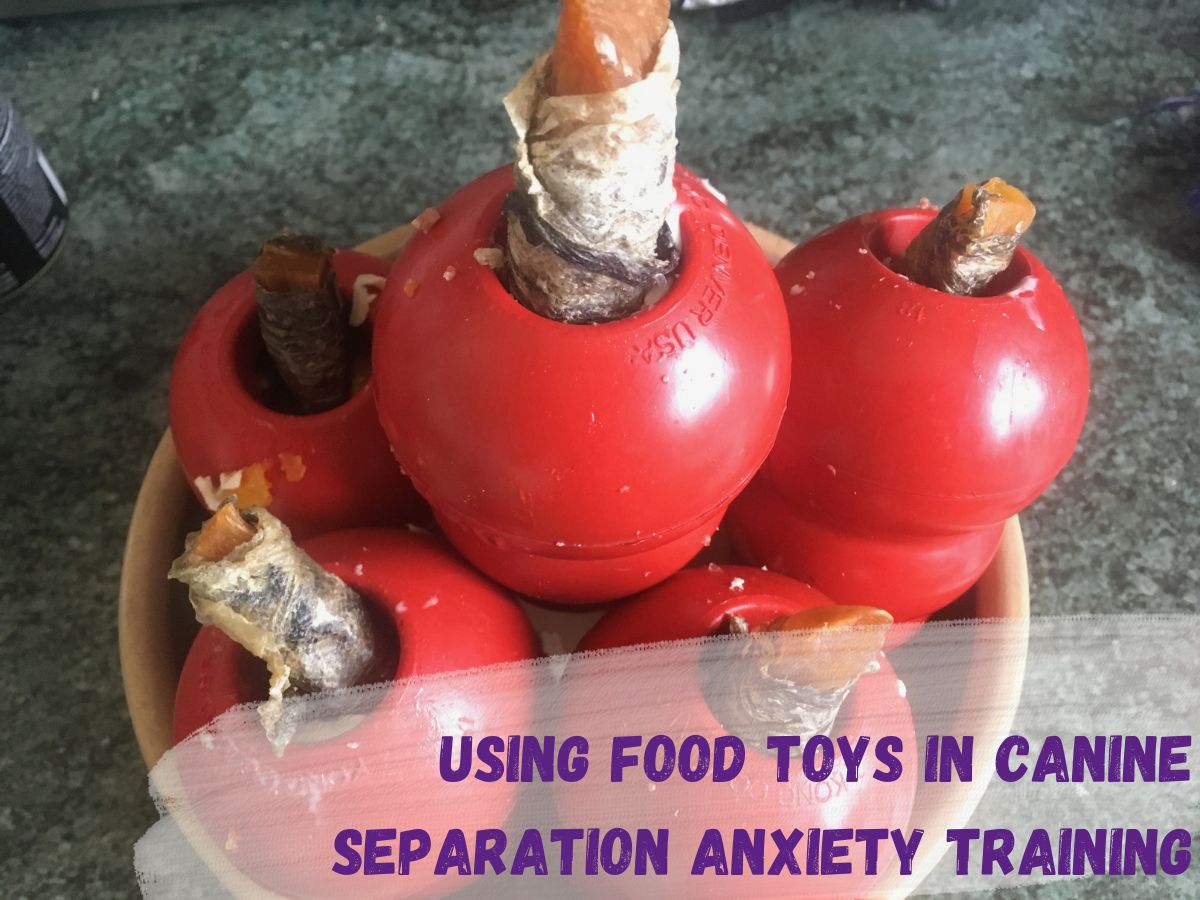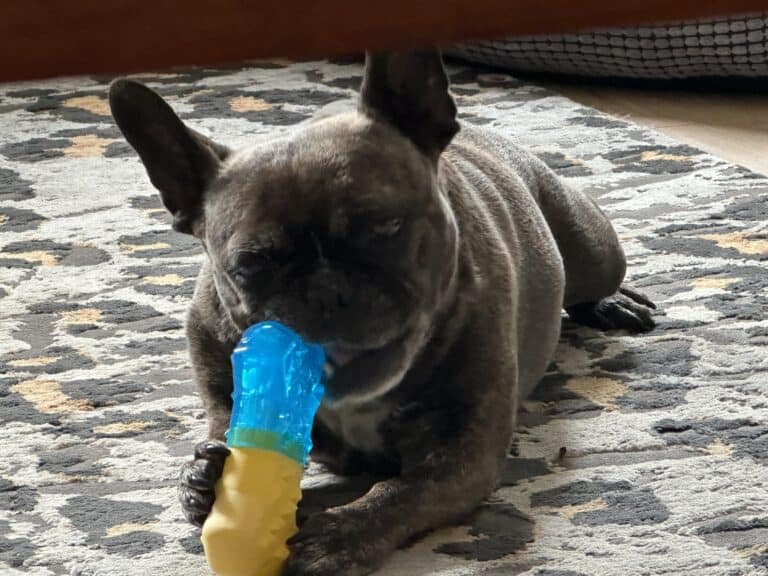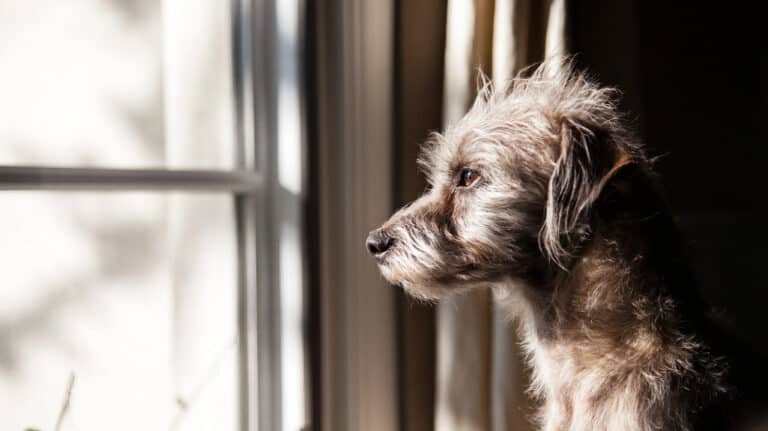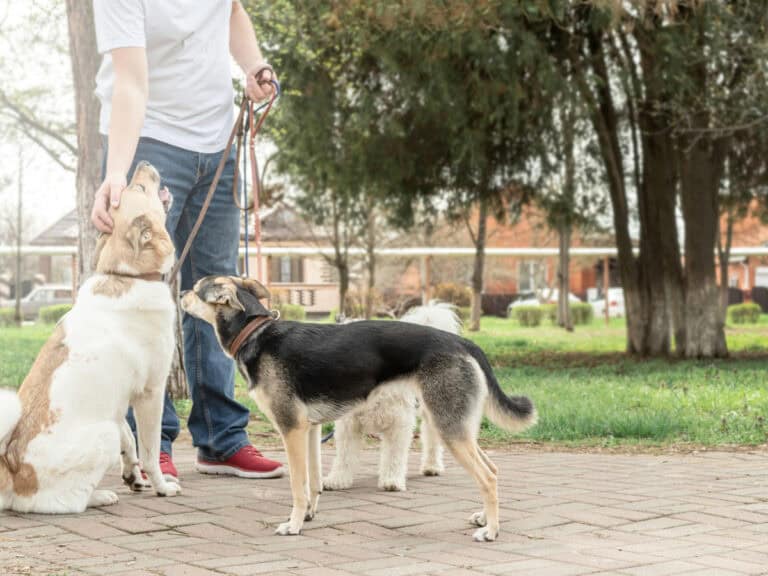Why we don’t use food in canine separation anxiety training
The Pet Coach features affiliate links and participates in the Amazon Services LLC Associates Program. If you choose to make a purchase through one of these Amazon links, I may earn a small commission—at no additional cost to you. These affiliate earnings help support the website and allow me to continue providing free content for pet parents. For more details, please see my disclosure policy.
When training a dog with separation anxiety also known as isolation distress, many websites tell you to put a food toy down and your dog will be fine, yet you speak to a professional certified separation anxiety trainer and they say they don't use food in training, why is that?
If your struggling to train your dog with separation anxiety, you've probably read all of the books so perhaps you're wondering why using food as a tool isn't recommended?
In this article we're going to get into why CSATs don't generally recommend food in training dogs with separation anxiety and home alone, as well as what you can do instead.
While food can be great for reinforcing behaviours during operant conditioning (what you maybe think of as obedience or manners training), it mostly can't change a dog's association with being alone. Gradual exposure to being alone is necessary for them to learn it's not scary, done in a systematic and sometimes a painfully slow pace, at least to begin with while the dog learns that being home alone is safe.
Keep reading to discover the limitations of using food in separation anxiety work and explore alternative strategies for creating a positive association for your dog when being left alone.
Benefits of Using Food in Dog Training
Using food in dog training offers several benefits for reinforcing desired behaviours and motivating dogs to repeat those behaviours.
When dogs receive food rewards for performing the desired actions, they learn that these behaviours lead to positive outcomes. This creates a strong association between the behaviour and the reward, making it more likely for the dog to exhibit or repeat the behaviour again in the future.
Additionally, food rewards can be used effectively to shape and modify behaviour, allowing trainers and behaviourists to guide dogs towards desired actions. The use of food as a reinforcer can be particularly useful when teaching complex or challenging behaviours, as it provides an immediate and tangible reward that encourages dogs to continue practicing and improving their skills.
We typically use food reinforcement for Classical (Pavlovian) and Operant Conditioning tasks, and yes, positive reinforcement training works, really really well, the best in fact!
Reasons for Avoiding Food in Separation Anxiety Training
To effectively address separation anxiety in dogs, it's important to understand the reasons for avoiding the use of food in this type of training. Using food as a tool in separation anxiety training may seem beneficial at first, but it can actually hinder progress in the long run.
Here are four reasons why food should be avoided in separation anxiety training:
1. Food alone can't change a dog's association with being alone. While it can provide a temporary distraction, it doesn't address the underlying fear and anxiety that dogs experience when left alone. Think about how sad you feel when you eat that pint of ice-cream watching a slushy movie, the food doesn't really make you feel any better does it?
2. Giving food before experiencing the fearful event may have an opposite effect. Dogs may associate the food with the impending separation, leading to heightened anxiety instead of relaxation. The food can actually become poisoned, as it predicts you leaving, and your dog can start to refuse particular food toys if you only leave them when you're going.
3. Gradual exposure to being alone is necessary for dogs to learn that it isn't a scary situation. Distraction with food doesn't cure separation anxiety. Dogs need to learn to be relaxed and comfortable without relying on external stimuli.
4. The goal is for dogs to learn that being alone isn't a fearful situation. Using food as a distraction can create a dependency on it, preventing dogs from truly understanding and accepting being alone.
Benefits of Hiring a Certified Separation Anxiety Trainer
Hiring a Certified Separation Anxiety Trainer (CSAT) provides you with the expertise and guidance needed to help your dog overcome separation anxiety. We specialise in separation anxiety training for dogs and offer effective strategies tailored to each dog's needs. We can assist you in creating a personalised training plan and navigate the challenges that come with living with a dog with separation anxiety. By working with a CSAT, you gain access to our knowledge and experience in helping dogs overcome their fears and anxieties. We also provide you with the necessary tools and techniques to help your dog learn that being alone is not a scary or fearful situation. With their guidance, you can support your dog and ensure their well-being during times of separation.
Benefits of Hiring a CSAT separation anxiety specialist
- Provide you with advice learnt over years of experience
- Give you tailores stratergies and techniques for your individual dog
- Create a personalised training plan for your specific situation and the needs of your lifestyle and dog
Why you Should Use Feeding Toys for Dogs With Separation Anxiety
Using feeding toys for dogs with separation anxiety offers several benefits, but they shouldn't be used WHEN you're leaving the dog on their own. Confusing, isn't it?
Food toys offer dogs a chance to problem solve and enrich their day to day life, leaving them with feelings of positivity and a sense of acomplishment, This can be very powerful for a dog who may have a bit of a pesimistic outlook on life and be scared with absences or when left home alone.
You can make your own puzzle toys, or use a simple kong, as long as your dog enjoys it then that's the main thing.
Overall, while feeding toys can offer some benefits to a dog's daily life enrichment, they may not address the underlying issue of teaching dogs to be relaxed about simply being alone.
Problems With Using Feeding Toys for Dogs With Separation Anxiety
Using feeding toys for dogs who struggle with alone time can present several challenges that need to be considered. Using these toys as a solution may seem promising, but there are potential problems that can arise. Here are four important factors to keep in mind:
1. Many separation anxiety dogs won't eat when left alone: Dogs with anxiety disorders or who are under stress, often lose their appetite when they're alone, making feeding toys ineffective in these cases.
2. Dogs may learn to dislike the appearance of the food item: If dogs associate the feeding toy with their anxiety or panic, they may develop negative feelings towards it, hindering any progress.
3. Dogs can become reliant on the food as a distraction: Instead of learning to be relaxed when alone, dogs may just rely on the food toy as a temporary distraction from their anxiety.
4. Running out of food in the toy can trigger panic or vocalization: If the dog finishes all the food in the toy, it can lead to heightened anxiety, causing the dog to panic or become vocal.
Considering these challenges, it's important to explore other effective methods to help dogs with separation anxiety. The gold standard to treat separation anxiety is systematic desensitization preferably with the support of a CSAT following a separation anxiety protocol.
With our help, you really can get help on your dog's separation anxiety training journey.
Why don't we use food in canine separation anxiety training?
We don't use food in separation anxiety training because separation-related behaviors are not motivated by hunger or food. Separation anxiety is an emotional response, not a food-driven behaviour that you can reward.
What is separation anxiety in dogs?
Separation anxiety in dogs is a condition where dogs experience extreme distress and anxiety when left alone or separated from their owners. It can manifest in behaviours such as excessive barking, destructive chewing, and house soiling.
Why should I consult a separation anxiety specialist?
Consulting a separation anxiety specialist (CSAT) is crucial because they have the expertise and experience in dealing with this specific behavioural issue. They can create an effective separation anxiety training plan tailored to your dog's needs.
Can I leave my dog alone if they have separation anxiety?
It is not advisable to leave your dog alone if they have separation anxiety. Leaving them alone can exacerbate their anxiety and lead to destructive behaviors. It's important to gradually desensitize them to being left alone with the help of a professional dog trainer.
Will using food to distract my dog from their anxiety make the problem worse?
Using food to distract your dog from their separation anxiety may provide temporary relief, but it doesn't address the root cause of their anxiety. It's best to work on desensitization and counter-conditioning techniques to help your dog become comfortable with being alone.
What are some signs that indicate my dog has separation anxiety?
Some signs that indicate your dog may have separation anxiety include excessive barking, howling, destructive behavior, house soiling, pacing, and excessive salivation when you're about to leave the house.
How can I teach my dog to be comfortable when left alone?
Teaching your dog to be comfortable when left alone requires a gradual and systematic approach. Start by practicing short departures and gradually increase the duration over time. Provide your dog with interactive toys and establish a consistent departure cue.
Why do dogs eat the food when left alone?
Dogs may start eating the food when left alone because it temporarily distracts them from their anxiety. However, this behavior doesn't address their underlying emotional state and may mask the symptoms instead of addressing the root cause.
Can I give my dog a delicious treat before leaving to calm their separation anxiety?
While giving your dog a treat before leaving may temporarily calm their separation anxiety, it's not a long-term solution. It's better to work on desensitization and counter-conditioning techniques to help your dog build confidence and reduce their anxiety.
What are some subtle signs that my dog may be experiencing separation anxiety?
Some subtle signs that your dog may be experiencing separation anxiety include lip licking, yawning, excessive shedding, pacing, and seeking constant reassurance when you're about to leave or return home.






